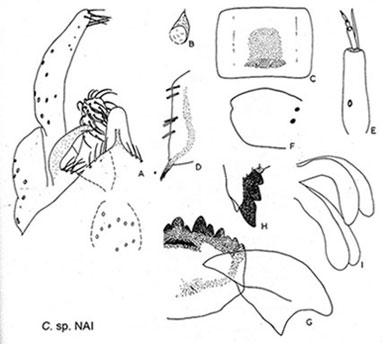Species 4x. C. sp. NAI of Proulx et al., 2013
also Chironomus nr. anthracinus
- Hamilton (1965)
Species 18 of Wülker as C. cf. aberratus
In BOLD Bin: BOLD:AAG5476
Some as Chironomus anthracinus-group.
The nearest neighbor to this species in the BOLD database is species 5TE from Norway.
Adult:
Described as C. rempelii by Hamilton (1965).

Hamilton's drawing of "C. rempelii"
Male:
AR: 5.23 - 5.58 (5.37,4)
Wing length 4.2 - 4.9 mm, VR about 1 or slightly higher.
LR 1.23 - 1.44 (3); fore tarsus with a long sparse beard.
Black or blackish with grey bands along the caudal margins of each abdominal tergite.
Head: frontal tubercles long, about 3x longer than broad., temporal setae in double irregular rows which extend medially to points midway between vertex angles of eyes and mid line of head. Palpal proportions (segs 2-5) 8 : 28 : 26 : 34. Clypeus large with 49 - 62 setae.
Thoracic setae: dorsocentrals in a double irregular row; prealar - 5-9; scutellum with two irregular rows and some random setae near centre line between these two rows.
Anal point very broad, superior volsella curved, E-type of Strenzke (1959) - Hamilton's illustration (see above) shows the distal end turned down, and different from the illustration of Townes (1945) for C. anthracinus. About 10 setae on tergite IX.
Pupa: Described as C. rempelii by Hamilton (1965).
Length 11.1 - 12.0 mm (7). Cephalic tubercle acute with a short bristle near the apex.
Abdomen: Tergite I not shagreened, tergites II-VI with shagreen on central and caudal part of disc, tergite VII with a fine patch of shagreen near each antero-lateral angle, and tergite VIII with two patches of shagreen on the cental part of disc; lateral filaments on segments V-VIII usually 4-4-4-5; caudolateral spur of segment VIII with 3 - 8 spines; anal lobes each with 120 - 170+ filaments.
Larva: A medium sized thummi-type larva, length about 14.8-22 mm (fem. 16.3-18.8; male 14.8-20.5). Gula dark to very dark over at least the posterior 2/3 and covering most of the width of the ventral head, slightly lower at outer edges; Frontoclypeus pale or very slightly darkened. Oesophageal opening 76-98.5 µm long and 3.6-3.9 times longer than deep.
Anterior Ventral tubules generally longer than posterior (Ant. 0.84-1.82 mm; Post. 0.8-1.7 mm). Anal tubules quite long (dor. 340-740 µm, vent. 340-880 µm); dorsal pair about 2.9-4.0, and ventral pair about 3.3-4.9, times longer than wide, as illustrated by Hamilton (1965) (see above).
Mentum (Fig d)with c2 teeth only slightly to moderately separated (type IIB-III), 4th laterals reduced to about the level of the 5th laterals (type II), 6th laterals lower.
Ventromentum (Fig e) about 240-273 µm wide, with smooth outer edge, 3.24-3.6 times wider than deep and 0.95-0.98 of the mentum width, with about 40-49 striae; VMR 0.27-0.32. Pecten epipharyngis (Fig a) with 10-18 sharp teeth. Premandible (Fig b) with moderately broad inner teeth, about equally long, inner tooth broad at base but narrowing markedly, inner about 3-4.5 times the width of the outer.
Antenna (Fig c) with A1 0.37-0.4 of Ventral head length and about 3.4-3.6 times longer than wide, RO near middle of segment; AR about 1.87-2.10; proportions (µm): 162 : 46 : 13 : 15 : 8.5.
Distance between antennal bases (200-225 µm) greater than distance between S4 setae (205 µm), which are separated by about 0.8 of the FC width; S5 setae level or posterior to nearby RO.
Mandible (Fig f) about 323-343 µm long, with third inner tooth only slightly separated and pale or slightly darkened (1I- IIIB), about 18-23 furrows on outer surface near base; 12-16 taeniae in Pecten mandibularis; Mdt-Mat 35, MTR 0.33-0.34.
Cytology: 4 relatively short polytene chromosomes with the thummi arm combination AB, CD, EF, G.
Appearance and sequences essentially as in C. anthracinus: Arm G generally paired with a nucleolus about 1/3 from the end. Arm F probably with a nucleolus near the characteristic bands. No polymorphism identified.
Oligotrophic, near-neutral lakes at depth of 4 to 7.5 m. A single generation per year.
This species is very similar to C. anthracinus. The population at Marion Lake was originally identified as C. rempelii, but Hamilton later provided larvae from the Lake as C. anthracinus.
Molecular: This species is largely identified by the mtCOI DNA sequences, which differ from those of C. anthracinus by 22 fixed differences (Table S4 of Proulx et al. 2013).

Comparison of COI sequences of C. anthracinus and Chironomus sp. NA1 of Proulx et al. (2013)
GenBank accession numbers: KF278219-20, KF278344
There is no difference in the gb2Β sequences between this species and C. anthracinus.
GenBank accession numbers: KF278390-92
Found: British Columbia - Marion Lake, Squamish (49.55; -123.18).
Ontario - Kasten Lake (46.37; -80.97), Sudbury area (Proulx et al. 2013).
[ Return to Index
| Go to References ]
|

